fierce heat radiated from the furnace, and also causes
the air that rushes into the furnace between the tiles,
a and b, to travel over the upper face of the tile,
b, on which the tar flows, thereby keeping it cool,
and preventing the tar from bursting into flame until
it reaches the edge of the tile, b, over the whole
edge of which it is made to run fairly well by a distributing
arrangement. A rapid combustion takes place here,
but some unconsumed tar falls on to the bed below.
About one-third of the grate area is filled up by a
fire tile, and on this the tar coke falls. The
tile, c, is moved away from time to time, and the
tar coke that accumulates in front of it is pushed
back on to the fire bars, e, at the back of the furnace,
to be there consumed. Air is thus admitted, by
three narrow slot-like openings, to the front of the
furnace between the tiles, a, b, and c, and under
c and through the fire bars, e. The air openings
below are about three times the area of the openings
in the front of the furnace; but as the openings between
the fire bars and the tiles are always more or less
covered by tar coke, it is impossible to say what
the effective openings are. This disposition answers
admirably, and requires little attention. Three
minutes per hour per fire seems to be the average,
and the labor is of a very light kind, consisting of
clearing the passages between the tiles, and occasionally
pushing back the coke on to the fire bars. These
latter are not interfered with, and will not require
cleaning unless any bricks in the furnace have been
melted, when a bed of slag will be found on them.
THE AMOUNT OF DRAUGHT
required for these fires is very small, and less than
with coke firing. I find that 0.08 in. vacuum
is sufficient with tar fires, and 0.25 in. for coke
fires. The fires would require less attention
with more draught and larger tar supply, as the apertures
do not so easily close with a sharp draught, and the
tar is better carried forward into the furnace.
A regular feed of tar is required, and considerable
difficulty seems to have been experienced in obtaining
this. So long as we employed ordinary forms of
taps or valves, so long (even with filtration) did
we experience difficulties with the flow of viscous
tar. But on the construction of valves specially
designed for the regulation of its flow, the difficulty
immediately disappeared, and there is no longer the
slightest trouble on this account. The labor
connected with the feeding of furnaces with coke and
cleaning fires from clinker is of a very arduous and
heavy nature. Eight coke fires are normally considered
to be work for one man. A lad could work sixteen
of these tar fires.
COMPOSITION OF FURNACE GASES.
Considerable attention has been paid to the composition
of the furnace gases from the tar fires. The
slightest deficiency in the air supply, of course,
results in the immediate production of smoke, so that
the damper must be set to provide always a sufficient
air supply. Under these circumstances of damper,
the following analyses of combustion gases from tar
fires have been obtained:




